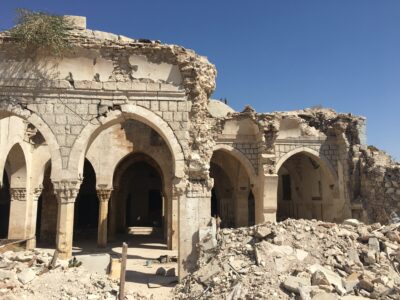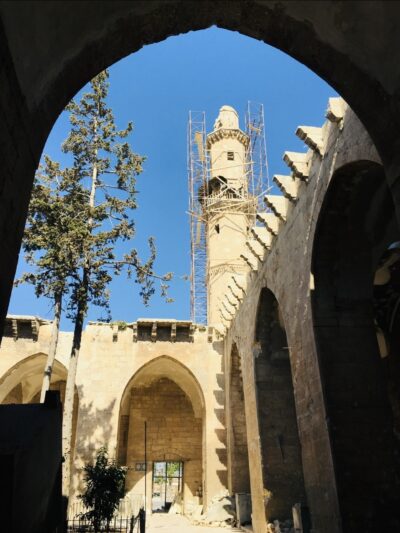Rebuilding Aleppo as a Liveable City: The Role Of Cultural Heritage
How to rebuild a city after a devastating war? Dalia Mokayed emphasises the crucial role of cultural heritage.
Earthquakes have rattled cities to rubble, fires have burned them to ashes, and wars have destroyed and flattened cities. War is considered the most violent shape of destruction, which, in addition to human loss, commits devastating violence against the urban fabric of cities. Managing the post-war heritage sites is considered the first step toward rebuilding cities. Also, maintaining post-disaster heritage sites will extend their life for sustainable use by the community and will help to rebuild identities.

The main entrance to the ancient citadel of Aleppo © Dalia Mokayed
Cultural Heritage and Humans in Aleppo are United in Tragedy
“The name of Aleppo raises emotions, and the image of a glorious past of an attractive historic city with the architecture of world renown on a legendary trading route” (quote from the Development Plan for the Old City of Aleppo). The old part of the city – a location of ancient heritage and a UNESCO World Heritage Site since 1996 – suffered from destruction during the conflict. The war has affected people and devastated the infrastructure and sites of cultural heritage in the city: a kind of damage that makes us feel Aleppo will never come back to life again.
During conflicts, cultures and people are facing the same danger and the same destiny. They are together in the tragedy. The cultural heritage under attack is the heritage of the people, their identities and memories. The destruction of Aleppo during the conflict combined culture and humans in one of the most ancient places on earth.
Cultural Heritage and Aleppo’s Identity: A Short History
Aleppo has been occupied and ruled by different empires, including Hittite, Assyrian, Babylonian, Persian Seleucid, Roman, Muslim Arab, Turkish, and the French; it was Arab and Turkish, Kurdish and Armenian, Christian, Muslim, and Jewish. During its time of prosperity as a trade city, one of the important trade destinations, and a stop on the Silk Road, Aleppo became a city of consuls where business was done. Venice, France, England, and the Netherlands had their consuls in Aleppo. “It was a Levantine city characterised by its location near the Mediterranean, the prominence of international trade and foreign consuls, the use of international languages, such as lingua franca or broken Italian, and later French; relative tolerance, and balance between different communities. No single group was exclusively dominant”, as Philip Mansel notes in his book on Aleppo. The diversity in Aleppo, and the openness to other cultures, made the people more flexible, and it has enriched their culture.
The people of Syria, and Aleppo especially, have a lot of traditions and cultural attributes that they proudly maintain, such as Aleppo cuisine, music and traditional Aleppo songs, and oral heritage (the traditional proverbs). Aleppo people are famous for their love of music: throughout history, their musicians have been able to use the inherited tunes to create long-lasting songs, and people are still enjoying them today. They are also famous for a rich cuisine influenced over time by other cuisines and able to influence other cuisines, for creating recipes with unusual combinations and unique flavours. Haim Sabato wrote in his book ‘Aleppo Tales’: “The people of Aleppo extol the food of their city and its delicacies. They don’t eat to excess but they expend inordinate effort and employ meticulous precision in the preparation of dishes”. The conflict, the displacement and the forced migration of its people affected many aspects of this intangible heritage.

The damage in Al Jdaydeh neighborhood, the old city of Aleppo © Dalia Mokayed
The Meaning of Cultural Heritage for Aleppo’s Displaced People
Many have noted that culture brings us meaning and a sense of belonging, unifying us through having a common history or language. The people during the conflict, especially those who fled the city, started sharing on social media and expressing how much they miss the city, and how they feel sorry for what was happening there. Many in-person and virtual events and initiatives were established to maintain and refresh the memories of the people about their culture, traditions, and heritage inside and outside Syria.
Musical events were organised, and cuisine books were published. A national team also started the initiative of collecting Aleppo’s oral heritage, besides several Facebook groups which have taken it upon themselves to salvage their heritage. One group (Halabia Antika) reached over 150,000 Aleppians of different faiths and ethnicities, sharing memories of their traditions and way of life before the war. These efforts reflect a high awareness of the importance of heritage in preserving cultural identity and connecting people to the city.
Cultural Heritage as a Means of Healing
The correlation between people and heritage has the potential to heal cities after years of displacement and destruction. Including and involving people, especially the youth, in the rebuilding process, educating them and raising their awareness of the value of their heritage is key in planning for the future of their city. They can heal the heritage, and heritage can heal them.
It has been argued that “the reconstruction of cultural heritage in the aftermath of war could play a major role in rebuilding a healthy post-conflict society.” During the last few years, the work of different stakeholders in rebuilding Old Aleppo has been very impressive. The partnership and the involvement of international agencies and the local authorities in different projects all have brought back hope that the city of Aleppo will rise from ruins. The love for the city and the dedication to rebuilding it will serve the right path, with specific guidance and a comprehensive long-term plan.

Renovation work in the old city of Aleppo 2019 © Dalia Mokayed
This is a long-term process, and it’s important to make sure that people won’t leave their heritage behind. We can achieve this through the involvement of cultural and educational facilities like museums and the university in educational and awareness-raising processes. Building trust bridges between political decision-makers and people is important in this phase; people should know that they are part of the process and that the reconstruction is serving them and their city.
Furthermore, a city like Aleppo must not be rebuilt merely as a tourist attraction. Tourism has always been an important component in Old Aleppo, but it wasn’t the main component. The city has survived the test of time because of its residents, and it has always been attractive because of the spontaneity of life in it. In modern history, cities that were raised from ruins after wars employed different approaches. Finding the balance between the planning for historic and modern areas will help provide more orientation and a sense of identity.
